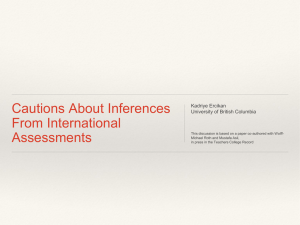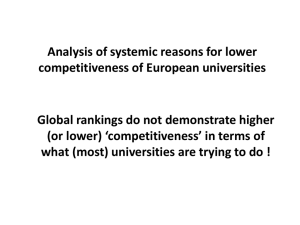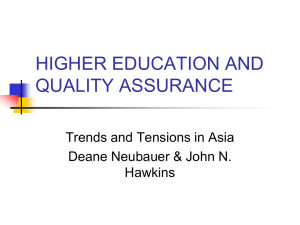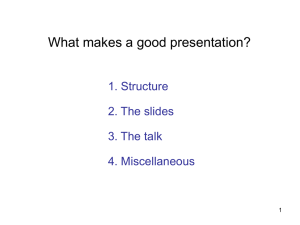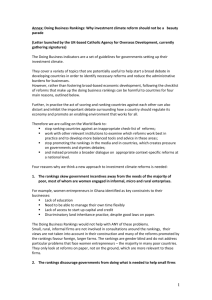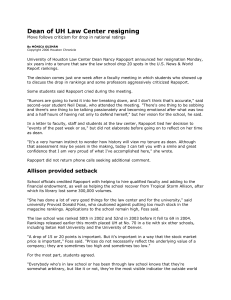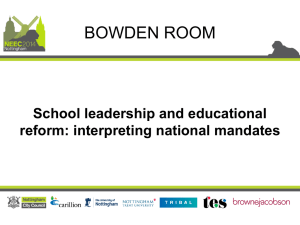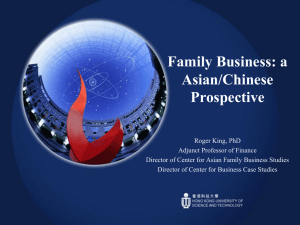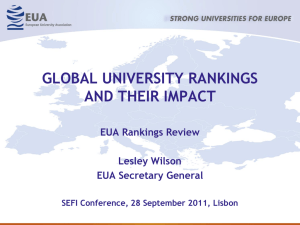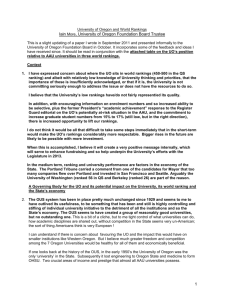Quality of education and educational assessment
advertisement
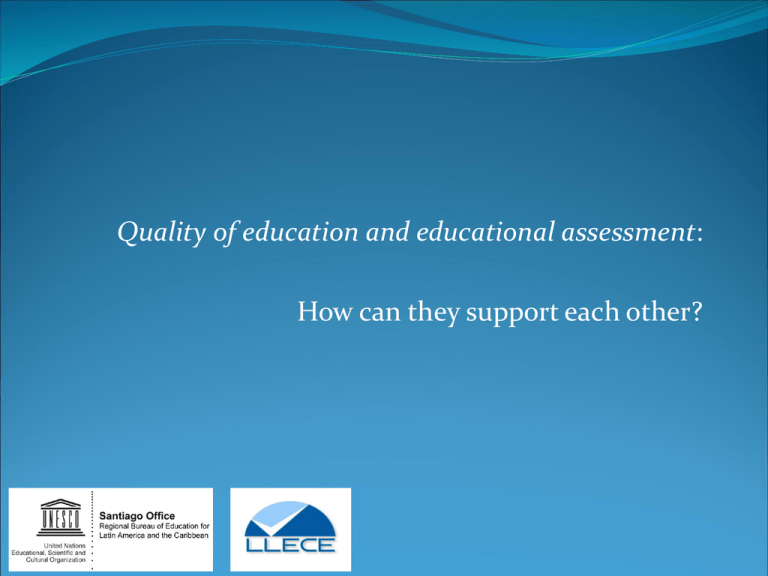
Quality of education and educational assessment: How can they support each other? What is ‘quality’ (of education)? Goal 6 of EFA Quality vs. Quantity (qualitative and quantitative research) In education: Quality vs. Access Relates to goal Nº 6 of EFA With > 95% access in LAC (ANER 2008), this is the principal focus of UNESCO in the región What is education? Teaching + Learning = Education Conceptualisations of quality of education: several models The Tikly model (2010): policy, school and home / community The UNESCO Santiago model Relevance: Learning which prepares for life Pertinence: Educational offer relating to distinct groups Equity: Education that does not discriminate Effectiveness: Achieving goals related to access Efficiency: Effective use of resources The international understanding: access rates and rankings The international understanding on monitoring of educational progress is that: Access is measured by means of access rates (such as GER, NER, ANER, etc.) – there is a difference between enrolment and attendance Quality is measured by means of (international) assessments of learning outcomes: almost always resulting in ‘rankings’ Kenya: attempting to increase without considering quality Source : Somerset, A. The generic CIPP model Generally speaking, the conceptualisation of (measuring) quality of education has shifted from input indicators to outcome indicators The focus nowadays being on education outcomes, there is a risk of losing the view on how we achieve these results Rankings: a look at SERCE In SERCE, there are three clear groups of countries: Achievement above average achieved by CUB Achievement at average level achieved by CHI, CRI, MEX and URU Achievement below average by ECU, GUA, NIC, PAN, PAR and RDO Further, PER and SAL are between groups 2 and 3 [Analysis: PREAL, Políticas 37] Access and achievement according to the SERCE data ¿Donde están los países en resultados y acceso? Tasa neta de matrícula y resultados en lenguaje en 3° de primaria Puntaje promedio SERCE 650 CU 600 CH 550 ME COL 500 NI 450 PAR BRA GU AR UR PE PAN EC RD 400 350 75 80 85 90 Tasa neta de matrícula primaria 95 100 105 Relation between investment and achievement in SERCE Gasto Público por alumno en primaria y resultados en lenguaje de los alumnos de 3° grado Puntajes promedio SERCE 600 CR CH 550 ME COL UR 500 PE BRA AR PAN PAR GU 450 R2 = 0,3301 400 350 5 7 9 11 13 15 GP por alumno como % del PIB per-capita 17 19 21 Statistical ‘artefacts’ In Chile, is the private subsidised school really better than the municipal, or public, school? (See graph) In Lebanon, for example, sometimes learners are excluded from the last year of study, as their results might impact negatively on the overall score of a school Source: presentación Dr Schiefelbein Rankings: a look at PISA 2009 The ‘tiger mother’ and her retreat The year 2010 saw the debate on the tiger mother in the United States The tiger mother was an idea of author Amy Chua: the Chinese mother who makes sure her children achieve excellent results in education - typically, she maintains an ‘iron’ discipline in her family Tragical cases of suicide have led to doubt around excessive discipline PISA 2009 in the region Reading Maths Sciences The data from PISA 2009 suggest that the countries of the region have an average achievement below OECD average in all subjects Nevertheless, the ‘best’ countries in SERCE are also the ‘best’ in SERCE (i.e. CHI, MEX, URU) Chile 449 421 447 439 Uruguay 426 427 427 427 Mexico 425 419 416 420 T&T 416 414 410 413 Brazil 412 386 405 401 Colombia 413 381 402 399 Argentina 398 388 401 396 Panama 371 360 376 369 Peru 370 365 369 368 An alternative ranking: inequality as per PISA 2009 (Duncan Index) Source : El Mercurio, 17 abril 2011, p. D21 What do teachers have to do with this? Source : Apuntes – Revista de Educación, p. 24 (TEDS) More rankings: the globalising market of tertiary education Nowadays, tertiary education has become a market of global dimensions International / intercontinental mobility in 2007, according to UIS: 2.8 mlln. Principal direction: from Asia Pacific to Europe and North America Has knowledge become a Source: UIS GED 2009 consumer good? Is education not important at the tertiary level? Ra nk There exist several rankings: Times Higher Education Supplement; Shanghai Jiaotong (ARWU); Webometrics, etc. The methodology includes variables related to research, but usually not related to education (the exception: AHELO) Institution Country 1 University of Cambridge United Kingdom 2 Harvard University United States 3 Massachusetts Institute of Technology (MIT) United States 4 Yale University United States 5 University of Oxford United Kingdom 6 Imperial College London United Kingdom 7 UCL (University College London) United Kingdom 8 University of Chicago United States 9 University of Pennsylvania United States Columbia University United States 10 Added value University rankings usually favour ‘western’ universities, but: They do not have the same average student entry-level They often have a languageadvantage Therefore, the moment of measurement does not reflect the ‘added value’ in terms of education The rankings do not reflect institutional achievement Université de Ouagadougou University of Oxford Therefore… To what extent do rankings tell us something about all the areas that education could address? (See, for example, Gardner´s model of multiple intelligences) To what extent do rankings tell us something about how systems achieve the level they ultimately achieve, according to the rankings? (For example, inclusively or not, and under which circumstances) Source: representation of a model by H. Gardner También a considerar: la definición de competencias A competency (working definition, Opertti et al.) is: A competency implies the generation, mobilization and integration of resources such as knowledge, knowhow, skills, attitudes and values aiming to enable one to act effectively while facing different changing life situations. It implies mobilizing capacities (knowledge and know-how) to read the contexts and act consequently avoiding stereotype responses. People Education It is important that education systems can develop skills that are not only ‘relevant’ to a context, but ‘transformational’ Society How to improve: the remedy is not always the same Poor › Reasonable G0od › Very Very good › Reasonable › Good good Excellent Teachers and HT Assessment Information systems Policies and laws Standards, curriculums Remunerati on Armenia: centralised teacher training programme Singapore: increased flexibility for teachers What are we assessing when we are assessing education? Schools: leadership, infrastructure Teachers: ability, training Family / socioeconomic context Learners: inherent aptitude, motivation Assessment System: curriculum, policies, resources How can we improve assessment for learning? It has already been said, but should be reiterated: assessment is not only descriptive, but also normative Let us, therefore, reconsider assessment methods: Can assessment be group-wise instead of focused on an individual (as inter-personal skills and teamwork are paradigmatic for the concept of 21st century skills)? Non-standardised assessment: practical tasks, inter-disciplinary problems, creative achievements Relation between knowledge, attitude and behaviour Programme evaluation: instances of violence in a school / community context Questions for discussion Which are the values, skills and knowledge (competencies) which education should instill for a local and a global society? How can we rethink assessment so that it captures and promotes, to a greater extent, quality education for all? Can we think of horizontal assessment, which classifies according to talent / interest, rather than in ‘vertical’ terms, that is to say, which classifies are ‘better’ or ‘worse’? Gracias / Thank you / Obrigado / Hartelijk dank Moritz Bilagher OREALC-UNESCO Santiago
